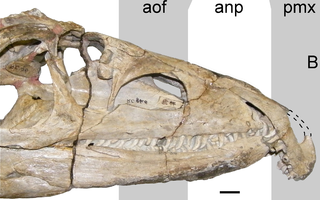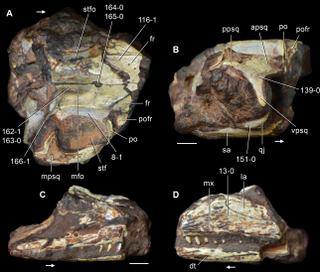
Archosauriformes is a clade of diapsid reptiles encompassing archosaurs and some of their close relatives. It was defined by Jacques Gauthier (1994) as the clade stemming from the last common ancestor of Proterosuchidae and Archosauria. Phil Senter (2005) defined it as the most exclusive clade containing Proterosuchus and Archosauria. Archosauriforms are a branch of archosauromorphs which originated in the Late Permian and persist to the present day as the two surviving archosaur groups: crocodilians and birds.

Archosauromorpha is a clade of diapsid reptiles containing all reptiles more closely related to archosaurs rather than lepidosaurs. Archosauromorphs first appeared during the late Middle Permian or Late Permian, though they became much more common and diverse during the Triassic period.

Erythrosuchidae are a family of large basal archosauriform carnivores that lived from the later Early Triassic (Olenekian) to the early Middle Triassic (Anisian).

Erythrosuchus is an extinct genus of archosauriform reptiles from the Triassic of South Africa. Remains have been found from the Cynognathus Assemblage Zone of the Beaufort Group in the Karoo of South Africa.

Garjainia is an extinct genus of erythrosuchid archosauriform reptile from the Olenekian of Russia and South Africa. It was approximately 1.5–2 metres (4.9–6.6 ft) long. It contained two species, Garjainia prima from the Yarengian/Yarkenskian Supergorizont of Russia, and Garjainia madiba from the Burgersdorp Formation of South Africa. "Vjuskovia triplicostata", a name assigned to some erythrosuchid fossils from Russia, has been synonymized with Garjainia prima.

Proterosuchus is an extinct genus of archosauriform reptiles that lived during the Early Triassic. It contains three valid species: the type species P. fergusi and the referred species P. alexanderi and P. goweri. All three species lived in what is now South Africa. The genus was named in 1903 by the South African paleontologist Robert Broom. The genus Chasmatosaurus is a junior synonym of Proterosuchus.

Tasmaniosaurus is an extinct genus of archosauromorph reptile known from the Knocklofty Formation of West Hobart, Tasmania, Australia. The type species is T. triassicus. This genus is notable not only due to being one of the most complete Australian Triassic reptiles known, but also due to being a very close relative of Archosauriformes. Once believed to be a proterosuchid, this taxon is now believed to have been intermediate between advanced non-archosauriform archosauromorphs such as Prolacerta, and basal archosauriforms such as Proterosuchus. Features traditionally used to define Archosauria and later Archosauriformes, such as the presence of an antorbital fenestra and serrated teeth, are now known to have evolved prior to those groups due to their presence in Tasmaniosaurus.

Turfanosuchus is a genus of archosauriform reptile, likely a gracilisuchid archosaur, which lived during the Middle Triassic (Anisian) of northwestern China. The type species, T. dabanensis, was described by C.C. Young in 1973, based on a partially complete but disarticulated fossil skeleton found in the Kelamayi Formation of the Turfan Basin.
Fenhosuchus is an extinct genus of archosauriform. The holotype, IVPP V 2697, and referred materials have been found in the Hsishihwa locality at Wuhsiang, China, from the Upper Ermaying Formation. The locality dates back to the Anisian stage of the Middle Triassic. The genus was named after the Fen River in Shanxi Province from which specimens were found. It may prove to be a chimera being composed of material from several different animals. Some material were believed to represent a rauisuchid. The calcaneum of Fenhosuchus seems to belong to an erythrosuchid or other basal archosauriform. Much of the material of the tarsal bones seem to be similar to those of the genus Shansisuchus. According to Nesbitt (2009) the assessment of Gower (2000) was correct, the holotype is a mix of Shansisuchus remains and a possible fragment from a paracrocodylomorph or a dinosauriform. Thus, Fenhosuchus cannot be considered a rauisuchian.

Vancleavea is a genus of extinct, armoured, non-archosaurian archosauriforms from the Late Triassic of western North America. The type and only known species is V. campi, named by Robert Long & Phillip A Murry in 1995. At that time, the genus was only known from fragmentary bones including osteoderms and vertebrae. However, since then many more fossils have been found, including a pair of nearly complete skeletons discovered in 2002. These finds have shown that members of the genus were bizarre semiaquatic reptiles. Vancleavea individuals had short snouts with large, fang-like teeth, and long bodies with small limbs. They were completely covered with bony plates known as osteoderms, which came in several different varieties distributed around the body. Phylogenetic analyses by professional paleontologists have shown that Vancleavea was an archosauriform, part of the lineage of reptiles that would lead to archosaurs such as dinosaurs and crocodilians. Vancleavea lacks certain traits which are present in most other archosauriforms, most notably the antorbital, mandibular and supratemporal fenestrae, which are weight-saving holes in the skulls of other taxa. However, other features clearly support its archosauriform identity, including a lack of intercentra, the presence of osteoderms, an ossified laterosphenoid, and several adaptations of the femur and ankle bones. In 2016, a new genus of archosauriform, Litorosuchus, was described. This genus resembled both Vancleavea and more typical archosauriforms in different respects, allowing Litorosuchus to act as a transitional fossil linking Vancleavea to less aberrant archosauriforms.

Yonghesuchus is an extinct genus of Late Triassic archosaur reptile. Remains have been found from the early Late Triassic Tongchuan Formation in Shanxi, China. It is named after Yonghe County, the county where fossils were found. Currently only one species, Y. sangbiensis, is known. The specific name refers to Sangbi Creek, as fossils were found in one of its banks.

Rhadinosuchus is an extinct genus of proterochampsian archosauriform reptile from the Late Triassic. It is known only from the type species Rhadinosuchus gracilis, reposited in Munich, Germany. The fossil includes an incomplete skull and fragments of post-cranial material. Hosffstetter (1955), Kuhn (1966), Reig (1970) and Bonaparte (1971) hypothesized it to be synonymous with Cerritosaurus, but other characteristics suggest it is closer to Chanaresuchus and Gualosuchus, while it is certainly different from Proterochampsa and Barberenachampsa. The small size indicates it is a young animal, making it hard to classify.

Youngosuchus is an extinct genus of archosaur from the Middle Triassic of China. The type species is Y. sinensis. Y. sinensis was first described in 1973 as a new species of the erythrosuchid Vjushkovia. In 1985, it was reassigned as its own genus of rauisuchid. A 1992 study supported the original classification of Youngosuchus sinensis as an erythrosuchid, but more recent studies classify it as a "rauisuchian"-grade loricatan archosaur completely unrelated to Vjushkovia, which is most likely a synonym of Garjainia.
Guchengosuchus is an extinct genus of erythrosuchid archosauriform from the Early Triassic of China. It is known from a single holotype skeleton called IVPP V 8808, described in 1991 from the lower Ermaying Formation in Shanxi. The lower Ermaying Formation dates back to the Olenekian stage of the Early Triassic, making Guchengosuchus one of the earliest archosauriforms. IVPP V 8808 is a disarticulated skeleton including a partial skull, lower jaw, some vertebrae, a scapula, and forelimb bones. Like some other erythrosuchids, Guchengosuchus has a tall skull with a notch between the premaxilla and maxilla bones of the upper jaw. The ribs of Guchengosuchus each have three heads, a feature also seen in the Russian erythrosuchid Vjushkovia. When it was first described, Guchengosuchus was placed in the suborder Proterosuchia, a group that included the families Erythrosuchidae, Proterosuchidae, and Proterochampsidae and was thought to be closely related to a primitive group of reptiles called Eosuchia. Proterosuchia is now considered a paraphyletic assemblage of basal archosauriforms representing a series of successive branches of stem group archosaurs.
Jaxtasuchus is an extinct genus of armored doswelliid archosauriform reptile known from the Middle Triassic of the Erfurt Formation in Germany. The type species, Jaxtasuchus salomoni, was named in 2013 on the basis of several incomplete skeletons and other isolated remains. Like other doswelliids, members of the genus were heavily armored, with four longitudinal rows of bony plates called osteoderms covering the body. Jaxtasuchus is the first doswelliid known from Europe and is most closely related to Doswellia from the Late Triassic of the eastern United States. However, it was not as specialized as Doswellia, retaining several generalized archosauriform characteristics and having less armor. Jaxtasuchus fossils have been found in aquatic mudstones alongside fossils of temnospondyl amphibians, crustaceans, and mollusks, suggesting that Jaxtasuchus was semiaquatic like modern crocodilians.

Asperoris is an extinct genus of archosauriform reptile known from the Middle Triassic Manda Beds of southwestern Tanzania. It is the first archosauriform known from the Manda Beds that is not an archosaur. However, its relationships with other non-archosaurian archosauriforms are uncertain. It was first named by Sterling J. Nesbitt, Richard J. Butler and David J. Gower in 2013 and the type species is Asperoris mnyama. Asperoris means "rough face" in Latin, referring to the distinctive rough texture of its skull bones.

Teyujagua is an extinct genus of small, probably semi-aquatic archosauromorph reptile that lived in Brazil during the Early Triassic period. The genus contains the type and only known species, T. paradoxa. It is known from a well-preserved skull, and probably resembled a crocodile in appearance. It was an intermediary between the primitive archosauromorphs and the more advanced Archosauriformes, revealing the mosaic evolution of how the key features of the archosauriform skull were acquired. Teyujagua also provides additional support for a two-phase model of archosauriform radiation, with an initial diversification in the Permian followed by a second adaptive radiation in the Early Triassic.
Litorosuchus is a genus of armored, semiaquatic archosauriform reptile from the Middle Triassic of China, closely related to the morphologically similar Vancleavea. It contains one species, L. somnii.

Kadimakara is an extinct genus of early archosauromorph reptile from the Arcadia Formation of Queensland, Australia. It was seemingly a very close relative of Prolacerta, a carnivorous reptile which possessed a moderately long neck. The generic name Kadimakara references prehistoric creatures from Aboriginal myths which may have been inspired by ice-age megafauna. The specific name K. australiensis relates to the fact that it was found in Australia. Prolacerta and Kadimakara were closely related to the Archosauriformes, a successful group which includes archosaurs such as crocodilians, pterosaurs, and dinosaurs.

Polymorphodon is an extinct genus of archosauriform reptile from the Middle Triassic of Germany. The only known species is Polymorphodon adorfi, discovered in Lower Keuper deposits at a quarry in Eschenau, Germany. Polymorphodon is notable for its heterodont dentition, with long and conical premaxillary teeth followed by thin maxillary teeth with large serrations. Maxillary teeth near the back of the mouth are short and leaf-shaped, similar to some living and extinct reptiles with a herbivorous or omnivorous diet. This may suggest that Polymorphodon had some reliance on plants in its diet, a rarity among basal archosauriforms, most of which are carnivores.






















